Why is this trend most pronounced in the U.S.?
There’s a lot of cultural significance around coffee.
I worked in France for a French company. In France, coffee has a very particular taste, and you don’t mess with it. It’s in a small cup, and you don’t put cream in it, maybe sugar. There’s a lot of cultural context around what the taste of coffee is. What does coffee mean to your country?
In the U.S., we’ve had exposure to these types of sweet drinks such as iced coffee. Americans have a preference for iced things, weird for the rest of the world. We’re one of the few countries where you get a soda and it is loaded with ice. That has aligned well with coffee. It’s kind of a cultural preference that’s become very American.
We love our chocolate. We love our syrups, give us caramel, put whipped cream on it. I think my European coffee-drinking friends would say that it’s a horror what we’ve done to coffee. I would say it’s an amazing dessert.
Americans also like our energy drinks. Coffee, especially iced coffee, fits into that mid-afternoon slump. You can pick up a soda, but why not just pick up an iced coffee, which will give you that boost you need to get through the day? You certainly see this at Georgetown. Just check out at 3 in the afternoon to see all the med people [from Georgetown University Hospital] lined up at Starbucks.

How do coffee companies account for cultural differences in their marketing?
The companies are very good at this. You have to know your market and its taste preferences. Americans, we love our sweets, candies and cookies. In other countries, you might see different taste profiles, and some of them have come to the U.S. One I think about is matcha latte, which started not in the U.S. but has made its way here. We sweeten it a lot more probably than if you got a matcha somewhere else.
How do the customization options for iced coffee affect its marketability and popularity?
All of us want to feel like — to the brands that we like — we are the one and only and that our preferences matter the most. We love it when we think something can be customized to our taste preferences. It doesn’t matter if you’re at Starbucks, Dunkin’ or Coffee Republic down the street, listen to people’s coffee orders. They’re literally never the same — I want it half-sweet. I want it with a lot of ice. I want it with less ice. I want whatever it is.
By giving way to preference, it’s a way for brands and businesses to show us their love and their love for our uniqueness.
This also gets into the American psyche, where we are a country with a lot of diversity. We all want to feel like we’re getting our little special taste, and it makes us feel special.
Did consumers or coffee companies start this trend, and is iced coffee just a temporary fad?
It’s not that people have not been drinking iced coffee or that they created iced coffee as a concept, but I think [coffee companies] popularized it.
Everything in life and marketing is cyclical, but I don’t see hot coffee coming back anytime soon. I don’t think hot coffee is going away. But now, as millennials become parents and eventually Gen Z, they’ll introduce their kids to iced coffee, so I don’t see the trend going away anytime soon.


















